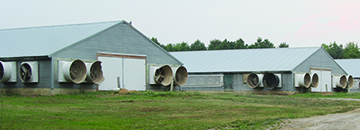By Linda Cicoira — An environmentalist who was speaking during the public participation portion of the Eastern Shore Groundwater Committee meeting Tuesday asked Tyson Foods to be satisfied with the number of poultry houses it now has in Accomack County.
“We need you on the Shore,” Ken Dufty said of the industry. “We’re not your enemies.” But, “We believe you have enough here. Stop the build-out.”
The Tyson representative, Doug Baxter, made no reply but appeared to be accepting Dufty’s remarks that his group sees the poultry industry’s value. Dufty is head of the activist group, Citizens For Open Government. He said real estate values have declined because of the influx of poultry houses.
The previous day, the State Water Control Board voted to support stiffer penalties for Tyson Foods for repeated wastewater and stormwater violations at a poultry plant in Temperanceville. The board levied a final penalty of $30,160 on April 15, compared to an initial proposed penalty of $16,500.
A report early this month from Delmarva Poultry Industry Inc. stated that the three state chicken industry increased its economic output by 18.6 percent in the past five years by producing 4.3 billion pounds of chicken worth $3.4 billion in 2018. The 20,425 employees of the industry earned $784 million in wages in 2018, and the region’s 1,302 chicken growers earned $268 million in contract income. In total, income earned by employees and farmers associated with Delmarva’s chicken industry was $1.05 billion.
“We’re not going to be able to tell the poultry people or anybody how to run their business,” said Chairman John Coker, who is also a Northampton supervisor. “I’m certainly not going to tell somebody how to run their business … I don’t know when enough is enough. I don’t think the scientists can tell us. We’re waiting for the scientists to tell us what really is going to happen to our water. We don’t know yet. We all have our gut feelings.”
“That’s why we’ve been working so hard to promote the Columbia” aquifer, said Britt McMillan, the groundwater committee’s hydrogeologist. McMillian was referring to the committee’s request that high water consumers take from the aquifer that replenishes the fastest. But only a few have done so.
A Department of Environmental Quality (DEQ) water withdrawal permit in Painter was discussed because the vegetable packing facility has promised to take 80 percent of its water needs from the Columbia.
An informational session about all the pending DEQ groundwater withdrawal permits will be held at 6 p.m., April 30, Nandua High School. Public hearings will follow on other dates.
Also discussed briefly was an Environmental Protection Agency (EPA) report on local Toxic Release Inventory (TRI) that was included in the committee’s agenda packet.
McMillan referred to them as “nebulous,” or vague, because it “doesn’t tell whether it is a problem or not.” He noted that the list is a “good place to start.”
The majority of the releases were for nitrate which is not considered as dangerous as metals.
A staff summary showed “five jurisdictions report more on-site releases than Accomack County. They are Montgomery, Covington, Chesterfield, Hopewell, and Isle of Wight. Perdue releases almost 13 times as much as Tyson and is responsible for 92.7% of TRI released in Accomack County.”
Peracetic acid, a bleaching agent for food starch and a component of antimicrobial washes for poultry carcasses and fruit is among the newer releases being seen. Baxter said the federal government requires its use. The staff characterized it as “a strong oxidizing agent and severe irritant to the skin, eyes, and respiratory system.”
The toxics releases as related to each facility are:
Perdue:
- 1.07 million pounds nitrate compounds, up from 699,640 in 2016, and more than double from 2015.
- 76 pounds peracetic acid to water, up from 29 pounds in 2016,
- 75,900 pounds hydrogen sulfide to air, down from 83,880 pounds in 2016.
Tyson:
- 56,996 pounds nitrate compounds to water, up from 31,053 pounds in 2016, and 22,332 pounds in 2015
- 30,441 pounds ammonia to air, up from 2,736 pounds in 2016
- 580 pounds of peracetic acid to air, up from 0.
KMX Chemical:
- 3,680 pounds ethylene glycol, up (up from 750 pounds) to air
- 346 pounds methanol, up from 250 pounds) to air
NASA-Wallops Flight Facility
- 526 pounds polycyclic aromatic compounds are managed on-site via recycling compared to none in previous years.
- In 2015, there were air releases of 27 pounds of chromium and 246.07 pounds of lead.
- In 2016, there was an air release of 88 pounds of lead.
- In 2017, 18 pounds of Naphthalene and 88 pounds of lead, both as air releases.



